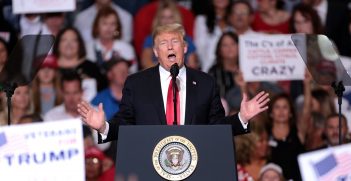2024 US Elections: Congress and Foreign Policy Beyond the Presidency

The Trump machine has once again dominated the media environment across the world. But don’t rule out America’s other electoral races in the US Congress, which will prove pivotal to US foreign relations.
For observers of American politics, the onset of 2024 marked the commencement of the much-anticipated election year. Though political tensions in the US have not mellowed much in the last decade, the international community has ramped up its commentary on the predicted presidential rematch. Less covered in the media are the 438 house seats and 34 senate seats up for grabs in US Congress.
Foreign audiences often confuse congressional powers with presidential powers. Though there are many, the most misperceived pertain to Congress’s ability to control the national budget and defence spending, declare war, and ratify treaties. With the potential for such a large shift in the electorate, the outcome of the Congressional elections is potentially a more significant issue than even another Trump presidency and will undoubtedly include important issues such as aiding Ukraine in its war against Russia, sustaining American commitments in the Indo-Pacific, and pushing back against China.
Campaign strategists for both the Democratic National Committee (DNC) and Republican National Committee (RNC) are acutely aware of the power that Congress can wield. For many of the individual campaigns – some 472 – strategists are required to lean on the spectacle of the presidential election and what is called the “coattail” effect. Popular presidential candidates or political party leaders attract votes for other candidates in his or her party and influence down ballot races. This becomes notably easier in a US election landscape where, in some states, voters can click a single “straight-ticket” button to vote at the top of the ballot. This instantly votes for every down ballot race (Presidential, Congressional, local, and otherwise), on the basis of political party.
While it may seem as though Americans are more divided along party lines than ever, polls increasingly indicate that the political tumult that has encompassed high-level candidates over the last several election cycles has caused a rise in independent and indecisive voters. A survey conducted by Pew Research in September 2023 found that a record number of (28 percent) of Americans are expressing unfavourable views of both parties. This figure is similar (nearly 33 percent) for young voters who are undecided on who they will vote for in the 2024 elections. As the research on undecided voters continues to accumulate, a crucial question is how consequential the coattail effect will be for congressional elections.
Senatorial elections unfold on a six-year cycle, introducing a staggered re-election pattern. This leads to certain election years showing a greater preference for one party in the Senate compared to others, as not all seats are up for re-election simultaneously, and contested seats are occasionally situated in states with strong partisan leanings. This election round, with 34 seats on the ballot, it is the Republican’s election to lose. While Democrats presently hold a slim 51-49 majority in the body, the electoral landscape suggests that Republicans are poised to retain all 11 of their currently held seats in staunchly red states. The Democrats face a more challenging landscape, with all 11 of their seats situated in contested states, along with 2 independents in states that remain uncertain. The Republicans are favoured to pick up at least two seats, with a majority of polls showing a 50-47 Republican control.
The House race will be much more unpredictable. Congressional House members must campaign every two years, and with such numbers, the House races are not skewed by which seats are up for grabs or affected by the electoral college. For this reason, the House race is considered much more of a reflection of American political sentiment. Its authorities cover the defence budget, the regulation of trade and tariffs, and the allocation foreign aid, among other important roles. On this basis, the House plays a pivotal role in shaping how the US government engages with its foreign allies. In a scenario where a polarising candidate such as Trump secures the presidency and the Senate, the balance of government can still be influenced by the outcomes of the popular vote for the House. If the majority of voters support a Democratic House, Democrats will have the ability to impede the Trump administration’s decisions on these critical issues for at least the next two years.
The House races will serve as the definitive indicator of the success or demise of the coattail effect. Out of the 435 seats, 218 seats are required to control the House. The Democrats are expected to secure around 204 seats, with Republicans around 211. The remaining 20 highly contested seats, then, will determine who controls the lower house. With Republicans favoured to win the presidency and the Senate, this nail-biting unpredictability will be the difference between a smooth sailing Republican government and a bureaucratic deadlock until 2026. Of course, polls have been wrong in the past. For the time being, the Democrats (as well as the rest of America and the world) have much to be concerned about.
Even if a party fails to gain the White House, the coattail effect will still be useful in mobilising party voters for lower-level races. Partly for this reason, spending on congressional and presidential races from external sources has reached US$318 million, marking a 600 percent surge compared to this same period in 2020. As a strategic financial approach, strategists will look to big and small donors who contribute to the presidential race to influence outcomes in down ballot elections. This fact that Congressional races will be influenced by elites and other powerful entities underscores the necessity for the general public to closely monitor and engage with these electoral contests.
The substantial impact congressional races will have on American foreign affairs emphasizes the attention the international community must pay to broader electoral outcomes. Often overshadowed by the reality tv-esque drama of presidential elections, the powers vested in the US Congress are equally, if not more, consequential for global affairs. In 2017, and again in 2018, the Trump administration sought to defund the Department of State and would have succeeded if not for Congress. Similar scenarios are envisioned for Trump 2.0, particularly on the Ukraine question.
Though comprehending the intricacies of down-ballot races and the coattail effect is a challenge, it stands as one of the most substantial stabilisers for foreign nations seeking to foster lasting relations with an unstable United States. By actively learning and being more conscious of the distinctive powers held by the president, in comparison to other bodies, the international community can facilitate more accurate and resilient policy responses.
Emily Mosley is the National Operations Manager at the Australian Institute of International Affairs. She worked on US Senate and Presidential campaigns from 2017 to 2022. Recognized for her work in Get Out The Vote (GOTV) initiatives and political advocacy, Emily is a recipient of the The Congressional Award Gold Medal and the George H.W. Bush Daily Point of Light Award.
This article is published under a Creative Commons License and may be republished with attribution.





